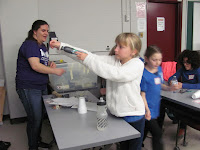
 On Saturday, March 25th, 7 Caledonia Guides and 1 Lone Guide joined Guides from across the region for the annual Engineering Day for Girl Guides at McMaster University in Hamilton. The focus for this years event was the Guide Physics Badge.
On Saturday, March 25th, 7 Caledonia Guides and 1 Lone Guide joined Guides from across the region for the annual Engineering Day for Girl Guides at McMaster University in Hamilton. The focus for this years event was the Guide Physics Badge.Our presenters for the day were Glenne, Tom, Veronika, Geoff and Natalie, who are all currently studying Engineering at McMaster. We started the day by learning a bit about the four types of science (math, chemistry, biology and physics) and 9 broad categories of engineering (electrical, mechanical, civil, biomedical, chemical, computer, software, physics and materials).
Session 1: Colours & Light
In our first session, we learned about Colours and Light and each girl built a periscope.
Properties of Light
- Reflection - light bouncing off surfaces
- Refraction - the bending of light as it passes through one thing to another
- Speed of Light - the fastest known speed, 300 million metres/second - light can travel around the world nearly 8 times in one second!
- Dispersion - separation of visible (white) light into its different colours
Periscopes allow a person to see around or over an object.
Session 2: Energy & Friction
Next, we learned about Newton's 3rd Law of Motion, Flight and Aerospace Engineering before building our own rockets!
Newton's 3rd Law of Motion: "For every action there is an equal and opposite reaction."
About Flight
- Flight is how objects move through the air.
- How do things fly? By making use of opposing forces - thrust and drag, lift and weight.
- Air has mass, pressure and temperature.
- Buoyant Flight - objects float through the air using a gas that is lighter than air (i.e. heated air in a hot air balloon)
- Aerodynamic Flight - objects use wings to fly through the air
- Rockets use (1) engines and (2) changes in air pressure (air is heated and used to propel the rocket upwards)
- There are no air particles in space, so less energy is needed once the rocket leaves the atmosphere.
- The first aircraft was flown by the Wright Brothers at Kitty Hawk in North Carolina on December 17, 1903. They traveled for 12 seconds, moving 120 feet.
- Study, design and test planes and rockets using their knowledge of math and physics
- Aeronautical Engineers design planes for use inside the Earth's atmosphere
- Astronautical Engineers design rockets for use in outer space.
After this session, we had a break for drinks and snacks, and the presenters played "Heads Up, Seven Up" with the girls.
Session 3: Forces
Our final session of the day involved learning about Energy and building projectile launchers!
Energy
- There are two types of energy:
- Kinetic Energy - Energy that is in motion (i.e. water, wind)
- Potential Energy - Energy that is stored (i.e. spring, elastic band)
- Potential Energy can be further divided:
- Gravitational Potential Energy
- if an object is at an elevation, it has gravitational potential energy
- dropping the object results in kinetic energy
- the work done to create the potential energy is the act of raising the object
- Elastic Potential Energy
- usually converted into kinetic energy (i.e. when you stretch an elastic band)
- Chemical Potential Energy
- energy can be stored in different atoms and molecules
- atoms are building blocks, molecules are a chain of atoms stuck together
- energy comes from breaking down these molecules (i.e. batteries, human stomach, car engines)
Downloads:










